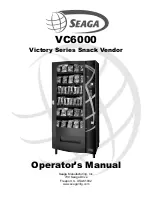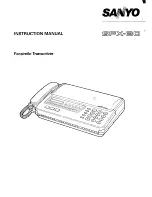
68
Troubleshooting
Problem
Cause
Reference
The needle thread
breaks.
1. The needle thread is not threaded properly.
2. The needle thread tension is too tight.
3. The needle is bent or blunt.
4. The needle is incorrectly inserted.
5. The needle thread and the bobbin thread are not drawn to the rear
and set properly under the presser foot when starting sewing.
6. The fabric is not drawn to the rear when sewing is finished.
7. The thread is too heavy or too fine for the needle.
Page 24
Page 32
Page 14
Page 14
Page 34
Page 34
Page 16
The bobbin thread
breaks.
1. The bobbin thread is not threaded properly in the bobbin holder.
2. Lint has collected in the bobbin holder.
3. The bobbin is damaged and does not turn smoothly.
4. The thread is wound loosely on the bobbin.
Page 22
Page 64
Replace the bobbin.
Re-wind the bobbin.
The needle breaks.
1. Needle is incorrectly inserted.
2. The needle is bent or blunt.
3. The needle clamp screw is loose.
4. A proper foot is not used.
5. The fabric is not drawn to the rear when sewing is finished.
6. The needle is too fine for the fabric being sewn.
Page 14
Page 14
Page 14
Use proper foot.
Page 34
Page 16
The needle thread
loops.
1. The needle thread tension is too loose.
2. The needle size is not suitable for the thread.
Page 32
Page 16
Skipped stitches
1. The needle is incorrectly inserted.
2. The needle is bent or blunt.
3. The needle and/or thread are not suitable for the fabric being sewn.
4. The needle thread is not threaded properly.
5. A poor quality needle is used.
Page 14
Page 14
Page 16
Page 24
Replace the needle.
Seam puckering
1. The needle thread tension is too tight.
2. The needle thread is not threaded properly.
3. The needle is too heavy for the fabric being sewn.
4. The stitch length is too long for the fabric.
* Use a stabilizer for very fine fabrics.
Page 32
Page 24
Page 16
Make stitch shorter.
The cloth is not fed
smoothly.
1. The feed dog is packed with lint.
2. The stitches are too fine.
3. The feed dog was not raised after being lowered.
Page 64
Make stitch longer.
Page 10
The machine does not
work.
1. The machine is not plugged in.
2. Thread is caught in the hook race.
3. The bobbin winder spindle is in the bobbin winding position.
Page 8
Page 64
Page 20
Patterns are distorted. 1. The stitch is not balanced.
Page 30
The buttonhole is not
sewn well.
1. The stitch density is not suitable for the fabric being sewn.
2. Interfacing is not being used with stretch fabrics.
Page 46
Use an interfacing.
Noisy operation.
1. The feed dog is packed with lint.
2. Lint has collected in the bobbin holder.
Page 64
Page 30





































